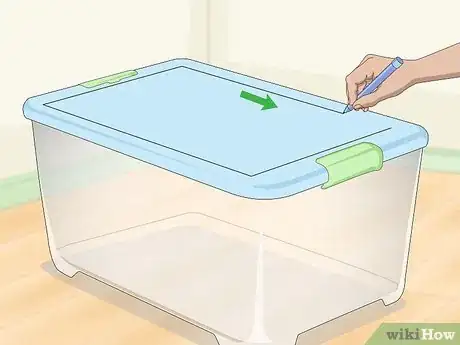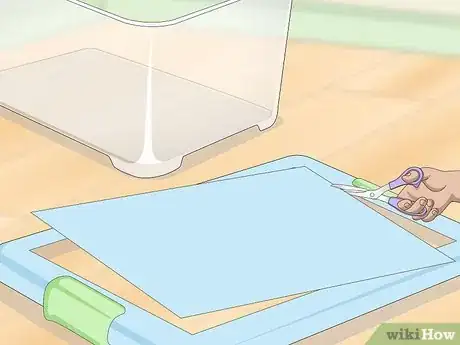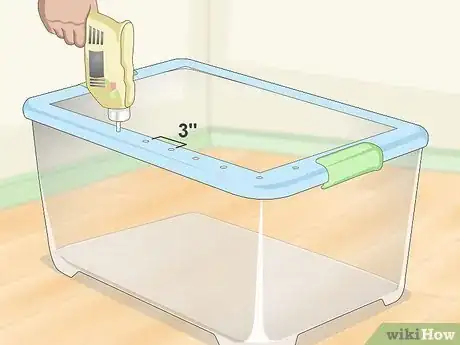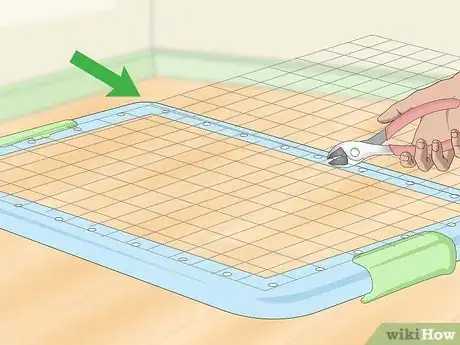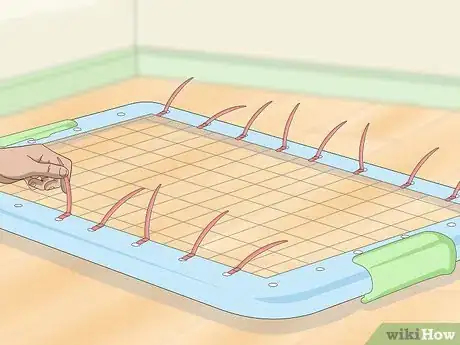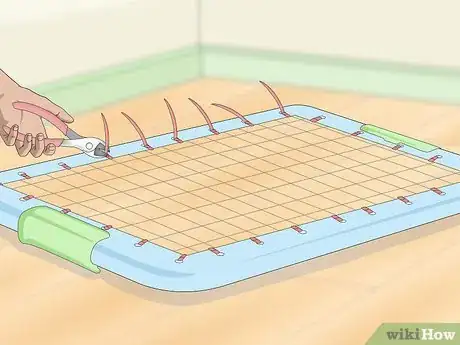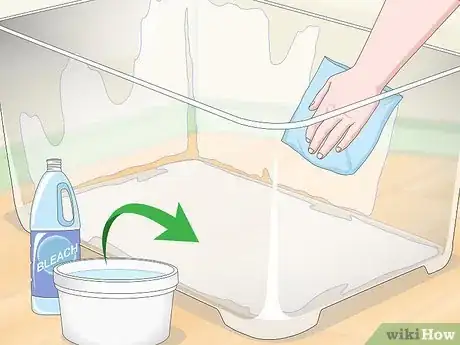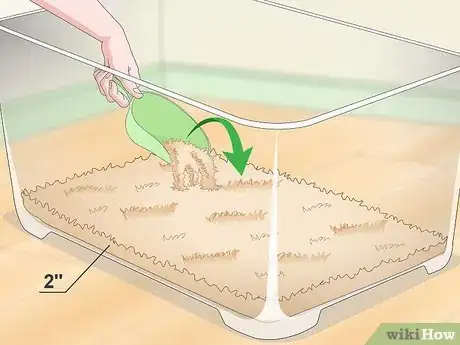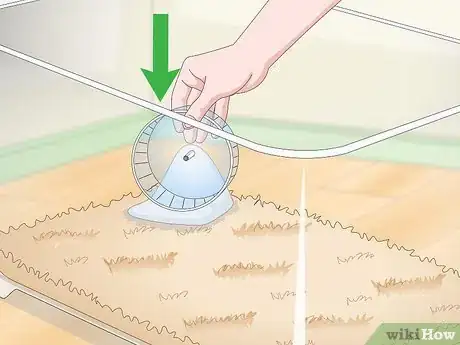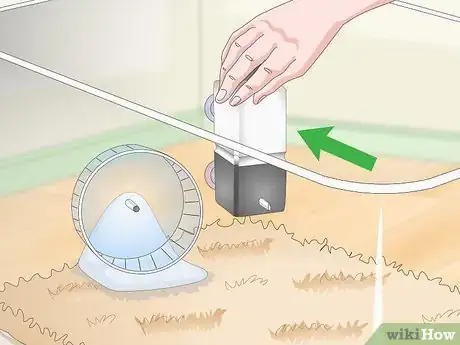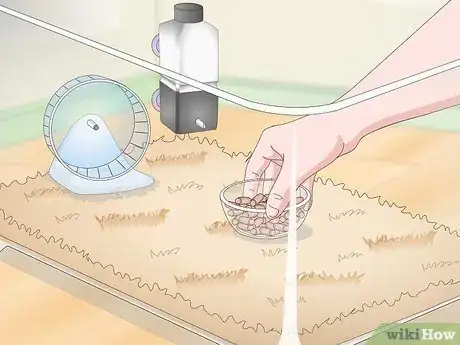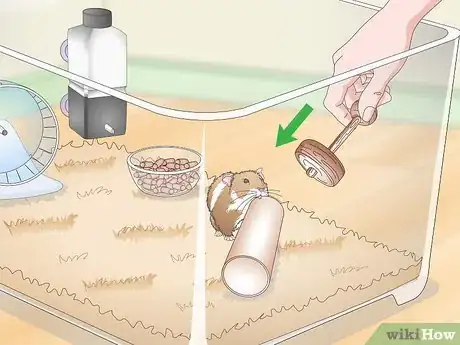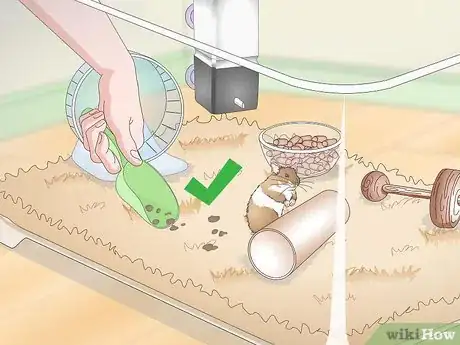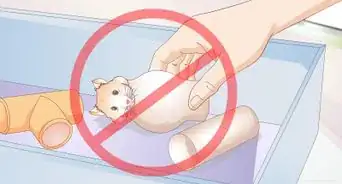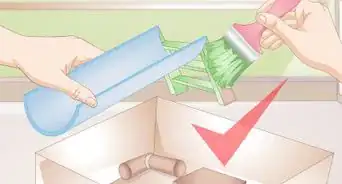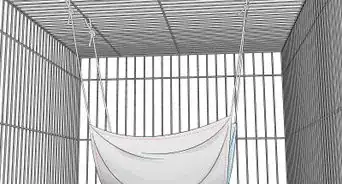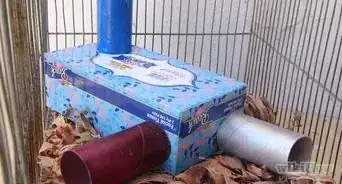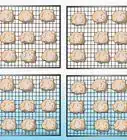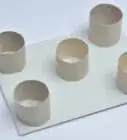This article was co-authored by wikiHow Staff. Our trained team of editors and researchers validate articles for accuracy and comprehensiveness. wikiHow's Content Management Team carefully monitors the work from our editorial staff to ensure that each article is backed by trusted research and meets our high quality standards.
There are 7 references cited in this article, which can be found at the bottom of the page.
This article has been viewed 212,125 times.
Learn more...
Hamster cages from the pet store can be expensive. Luckily, you can easily create your own affordable hamster cage with a plastic bin, some supplies, and a few tools. Before you create your hamster’s home, it’s important that you give the cage the proper ventilation and set it up with the right materials and equipment to allow your hamster to thrive. If you construct the hamster’s habitat properly and provide adequate food, water, and bedding, you can create a healthy environment for your pet.
Steps
Measuring and Cutting the Lid
-
1Purchase a clear plastic bin. Get a plastic bin with a lid online or from a department store.[1] You should get a cage that’s at least 600 square inches. This will give it enough space to move around and play.
- You can keep dwarf hamsters together but you should increase the size of the cage accordingly.
- You should house Chinese and Syrian hamsters in separate cages.
-
2Draw an outline of a rectangle on the bin's lid. Leave a 2 in (5.1 cm) gap between the lines of the rectangle and the edge of the lid. This space will be used to attach wire mesh so that your cage is ventilated.[2]Advertisement
-
3Cut out the center of the bin’s lid. Once you’ve drawn the outline, puncture the line with a knife or razor blade so you can start cutting it out. Then, use a pair of scissors to cut out the line and pop out the rectangular piece of plastic.[3]
-
4Drill holes every 3 in (7.6 cm) around the outside edge of the lid. Mark small circles around the outside edge of the lid every 3 in (7.6 cm) with a marker. Then, place the lid on the bin and use an electric drill with a 1⁄4 inch (0.64 cm) or larger drill bit to make the holes in each of the markings.[4]
- These holes will allow you to attach the wire mesh on the lid of the cage.
Attaching Hardware Mesh
-
1Cut out a piece of hardware mesh that’s the same size as the lid. Purchase hardware mesh online or at a hardware store. The mesh should be made of metal so that your hamster can’t chew its way out of the cage. Measure the length and width of the lid on your container with a tape measure or ruler. Then, cut out a piece of the mesh that’s the same size as the bin lid.[5]
- Mesh will keep the cage ventilated without allowing space for your hamsters to escape.
- Use wire cutters or a strong pair of scissors to cut the wire mesh.
-
2Attach the mesh to the lid with zip ties. Thread the zip tie through the mesh and then through the holes that you drilled in the lid. Secure the zip tie and pull on the end of it to tighten it to the cage. Repeat this process until you’ve attached the mesh to the lid at every hole.[6]
-
3Snip the excess ends off the zip ties. Cut the ends of the zip ties so that they don’t stick out. Your hamster cage is now ventilated. Before you put the hamster in its new cage, make sure you set it up properly.[7]
Setting Up the Cage
-
1Wipe down the inside of the bin with a diluted bleach solution. Fill a bowl with cool water and a drop of liquid bleach. Wear a pair of gloves and dip a rag into the solution and wipe down the inside of the bin, the mesh, and the lid to disinfect it. Then, dry the inside of the cage with a rag or paper towel.[8]
- Wiping down the cage with the bleach solution will prevent your hamster from getting sick from any harmful chemicals that may get on the bin when it’s being manufactured.
-
2Place a 6 in (15 cm) layer of bedding in the cage. Bedding will absorb the hamster’s urine and will make a comfortable home for it. Purchase paper bedding, cellulose fiber, or aspen shavings online or from a pet store and pour it into the bottom of the cage. Even out the bedding until there is a 2–4 in (5.1–10.2 cm) layer.[9]
- Don’t pack down the bedding so the hamster can burrow through it, use around 6-7 inches
- Avoid using pine and cedar shavings because it can give the hamster splinters and injure it.
- Use dye-free bedding to prevent your hamster from getting sick.
-
3Get a hamster wheel to give your hamster exercise. A hamster wheel will allow your hamster to run around and exercise even if there isn’t a lot of room in its cage. Young hamsters need to exercise more than older hamsters, so make sure you have one so that your hamster can grow up to be healthy and strong.[10]
- Get a 6.5 inches (17 cm) wheel for dwarf hamsters and get an 8 inches (20 cm) wheel for Chinese, Syrian, and other large hamsters.
-
4Install a water bottle to give your hamster a water source. Buy a hamster water bottle online or at a pet store. Attach command strips or velcro to the back of the bottle. Then, attach the other side of the velcro inside of the cage in an area that your hamster can reach. Hamsters like fresh water, so empty the bottle and replace it every day.[11]
- Do not fill a bowl with water because you hamster could drown.
-
5Put a bowl with food at the bottom of the cage. Get a small-pet bowl online or from a pet store and place it on top of the bedding in your cage. You can feed your hamster 10 g (0.35 oz) of hamster feed each day. You can also occasionally supplement its diet with some fruits and vegetables.[12]
- Hamsters will store food in their cheeks and hide it around the cage.
- Replace fresh food, like fruit, every day to prevent it from getting moldy.
-
6Give the hamster toys and accessories to keep it occupied. You can get small houses, wood chews, wooden balls, and other accessories for your hamster. This will give it something to do and give it a place to hide food and hide in. A hamster that has places to hide in their cage will be more relaxed than a hamster without toys or accessories.[13]
-
7Spot clean the cage daily and replace the bedding once a week. Hamsters will usually go to the bathroom in the same spot in their cage. Clean this area daily to make your weekly deep cleaning easier. Replace the bedding and wipe down the inside of the cage with a diluted bleach solution once a week to keep it clean.[14]
- Keeping your hamster cage clean will prevent your hamster from getting sick and will stop bad odors from forming.
Community Q&A
-
QuestionAre bin cages good for hamsters?
 wikiHow Staff EditorThis answer was written by one of our trained team of researchers who validated it for accuracy and comprehensiveness.
wikiHow Staff EditorThis answer was written by one of our trained team of researchers who validated it for accuracy and comprehensiveness.
Staff Answer wikiHow Staff EditorStaff AnswerBin cages are fine as long as they are well-ventilated and large enough to give your hamsters plenty of room to play, explore, and hide. They have the advantage of being less expensive than metal cages. However, you might opt for a metal cage or sturdier tank if your hamster likes to chew a lot, since they could easily damage the plastic.
wikiHow Staff EditorStaff AnswerBin cages are fine as long as they are well-ventilated and large enough to give your hamsters plenty of room to play, explore, and hide. They have the advantage of being less expensive than metal cages. However, you might opt for a metal cage or sturdier tank if your hamster likes to chew a lot, since they could easily damage the plastic. -
QuestionCan a hamster climb out of a plastic bin?
 wikiHow Staff EditorThis answer was written by one of our trained team of researchers who validated it for accuracy and comprehensiveness.
wikiHow Staff EditorThis answer was written by one of our trained team of researchers who validated it for accuracy and comprehensiveness.
Staff Answer wikiHow Staff EditorStaff AnswerIt’s certainly possible, especially if you have water bottles or toys along the sides of the bin that the hamster could climb up on. It’s always recommended that you attach a sturdy, well-ventilated lid to any hamster enclosure.
wikiHow Staff EditorStaff AnswerIt’s certainly possible, especially if you have water bottles or toys along the sides of the bin that the hamster could climb up on. It’s always recommended that you attach a sturdy, well-ventilated lid to any hamster enclosure. -
QuestionCan you put a hamster in a fish tank?
 wikiHow Staff EditorThis answer was written by one of our trained team of researchers who validated it for accuracy and comprehensiveness.
wikiHow Staff EditorThis answer was written by one of our trained team of researchers who validated it for accuracy and comprehensiveness.
Staff Answer wikiHow Staff EditorStaff AnswerYes, as long as the tank is large enough (e.g., around 40 gallons or about 150 liters). If it’s a glass tank, be very careful not to put it in an area where it will get direct sunlight. Glass tanks retain heat very well, so there’s a danger it could get too hot. Make sure to top it off with a mesh lid for good ventilation.
wikiHow Staff EditorStaff AnswerYes, as long as the tank is large enough (e.g., around 40 gallons or about 150 liters). If it’s a glass tank, be very careful not to put it in an area where it will get direct sunlight. Glass tanks retain heat very well, so there’s a danger it could get too hot. Make sure to top it off with a mesh lid for good ventilation.
Things You’ll Need
- 40 gallons (150 L) or larger plastic bin
- Marker
- Knife or razor blade
- Scissors
- Drill
- Hardware mesh
- Zip ties
- Bleach
- Cup or bowl
- Rag
- Rubber gloves
- Paper bedding, cellulose fiber, or aspen shavings
- Small-pet food bowls
- Hamster water bottle
- Hamster wheel
References
- ↑ https://hammyhappenings.wordpress.com/diy-hamster-cage-bin-cage/
- ↑ https://youtu.be/lAtVUvKs9Qg?t=42
- ↑ https://youtu.be/lAtVUvKs9Qg?t=42
- ↑ https://youtu.be/i5e-2yKLX2Q?t=186
- ↑ https://hammyhappenings.wordpress.com/diy-hamster-cage-bin-cage/
- ↑ https://hammyhappenings.wordpress.com/diy-hamster-cage-bin-cage/
- ↑ https://youtu.be/i5e-2yKLX2Q?t=275
- ↑ https://youtu.be/QtG_PDY6ooU?t=90
- ↑ https://petlifetoday.com/take-care-of-a-hamster/
- ↑ https://petlifetoday.com/take-care-of-a-hamster/
- ↑ https://petlifetoday.com/take-care-of-a-hamster/
- ↑ https://www.pets4homes.co.uk/pet-advice/caring-for-your-pet-hamster.html
- ↑ https://www.pets4homes.co.uk/pet-advice/caring-for-your-pet-hamster.html
- ↑ https://www.pets4homes.co.uk/pet-advice/caring-for-your-pet-hamster.html
About This Article
Buying a hamster cage from the pet store can be expensive, but luckily you can easily make your own cage out of a plastic bin, some supplies, and a few tools. Use a 15 to 20-gallon plastic bin with a lid. Cut a large rectangle out of the lid and replace it with wire mesh, which will keep the cage well ventilated. Wipe down the inside of the bin with a diluted bleach solution to prevent your hamster from getting sick from any harmful chemicals. Once the bin is dry, put 2 inches of paper bedding, cellulose fiber, or aspen shavings on the bottom of the cage. Add a hamster wheel, wood chews, a water bottle, and a food bowl to keep your hamster happy and healthy. To learn how to keep your hamster bin clean, keep reading!

